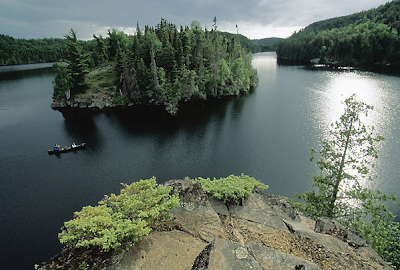In Physical Geography class we have been learning about the different types of landscapes and I have determined that Minnesota was formed mostly by glacier movements. For the last two million years until about 10,000 years ago, the majority of the state was covered with ice sheets.
This is a lake that was created about 10,000 years ago, at the end of the last ice age, when the glaciers retreated from this area in Zimmerman, Minnesota.
About two million years ago, the
first ice sheet moved over Minnesota; referred to as the Nebraskan Ice Stage.
This is a picture of the Nebraskan Ice Stage covering majority of the state of Minnesota.
During the Kansan Ice Stage, about 400,000 years ago, another ice sheet moved over the state which left a layer of glacial till that was about 50 feet thick. Glacial till is a mixture of boulders, gravel, sand and clay that is left behind as the glacier retreats from an area.
This is a picture of the Kansan Ice Stage covering the state of Minnesota.

This is an excellent example of the till that a glacier created while moving through this landscape.
The next glacier period was referred to as the Illinoian Ice Stage which occurred about 150,000 years ago. This ice stage is responsible for creating the moraines that you see in south-eastern Minnesota. A moraine is a ridge of glacial till that was left by the glacier; the hills that you see today are comprised of this.
This is a picture of the Illinoian Ice Stage covering the state of Minnesota.
This is a great example of a field of moraines left behind the glacier's path
http://vervoortantarctica.blogspot.com/2010_12_01_archive.html
http://vervoortantarctica.blogspot.com/2010_12_01_archive.html
The most recent glacier to move over Minnesota, the Wisconsin Ice Stage, lasted about 90,000 years and ended approximately 10,000 years ago. The majority of the landscape we see today was formed by this ice sheet. There was a huge field of drumlins created in Northern Minnesota. A drumlin is a line of glacial till that is shaped like a tear drop with the pointed end showing which direction that the glacier was moving.
This is a picture of the Wisconsin Ice Stage covering the state of Minnesota.
This is an beatiful example of many drumlins. You can see the tapered end on the left side of the picture that shows you where the glaciers moved into the area from.
The Earth is currently in an Ice Age that began about 2.5 million years
ago. Within this current Ice Age many cycles have occurred, they are known as
glacial and interglacial periods. Glacial periods are typically colder
temperatures and the expansion of ice sheets in the Northern and Southern
hemispheres. Interglacial periods are typically warmer temperatures and the reduction
of the ice sheets. The intervals between
glacial and interglacial periods can be anywhere from 40,000 to 100,000 years
apart.
In the next 1,000 years...
We will still be in an interglacial period. Temperatures will have continued to rise resulting in the glaciers melting significantly which will cause a substantial rise in the sea level. The rise in sea level causes a rise in the stream base levels as well so our rivers will have begun to flood, filling in the river valleys. We will no longer be the land of 10,000 lakes; we will be more like the land of 1,000 lakes because of the lakes will begin merging to form one huge lake instead of many different little ones.
An illustration showing us a futuristic view of what the rise sea level could succumb to.
A "funny" take on the effects of rising sea level.
Minnesota's overall landscape will begin to migrate north. The coniferous forests will move north because of their liking for a colder, arctic climate region. This will result in the prairie lands moving north because now they will be able to survive in these regions where they could not before.
This is a picture of the current beautiful coniferous forests in Northern Minnesota that will move north.
This is a map of Minnesota showing the current types of vegetation that occupy the state; in 1,000 years the praire grasslands will move over majority of the state.
In the next 100,000 years...
Scientists believe that cycles
between glacial and interglacial periods last anywhere between 40,000 to
100,000 years. Minnesota will be in another
interglacial period but we will have gone through a glacial period so the
landscape will be different.
The rivers will be cut deeper from the glaciers moving through the state. The hill's that are currently a part of the landscape will become more like foothills; the glaciers will cut back the land in the low lying areas at the base of these foothills.
This is how the Mississippi River could look in 100,000 years, a much more defined river by the glacier movements.
The current hills of Minnesota's landscape will become more defined as the glaciers move through the state.
In the next 1,000,000 years...
Minnesota will look dramatically
different because the landscape will have gone through many different
glaciation and interglaciation periods. We will be in a glaciation cycle in the
current Ice Age.
A comedic look at how the world would look in an Ice Age.
Minnesota will be covered with a
sheet of ice.
The vegetation of Minnesota will
have gone back to being majority dominated by coniferous forests almost no other plant life will be able to survive this climate. The animal
life will have changed to only those that can survive the cold, arctic
climates.
An example of the landscape of Minnesota in 1,000,000 years looks cold, frigid and baron.
References:











































